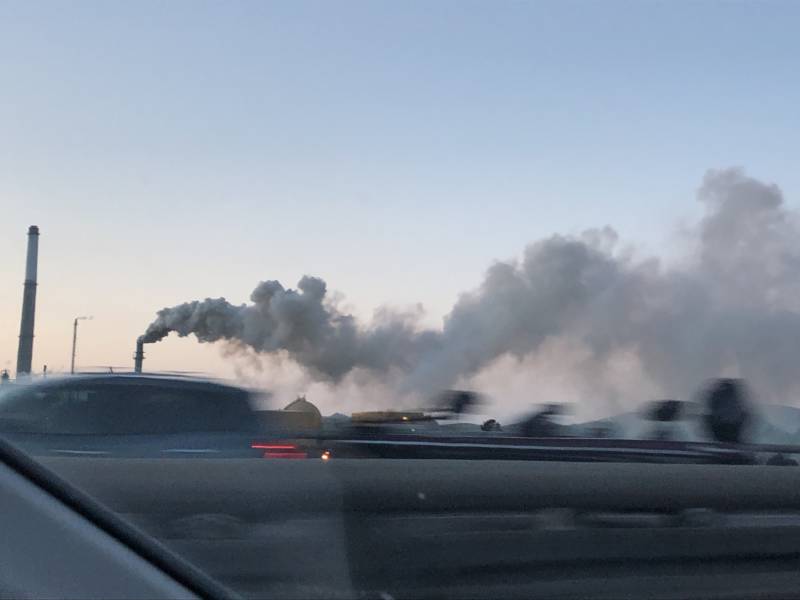"There's a lack of understanding about how coke particulates could be continuously emitted throughout a couple of weeks," Patterson said. "There's not a lot of information that's readily available to the public."
California's Division of Occupational Safety and Health began a probe into Valero on Monday, the day after the company began the gradual shutdown of a significant portion of the refinery, according to agency spokesman Frank Polizzi.
Cal/OSHA becomes the latest government agency to look into the breakdown of a key piece of equipment inside the refinery that went down two weeks ago. The Bay Area Air Quality Management District and Solano County officials have launched probes as well.
Refinery Problems Started Two Weeks Ago
On March 11, the facility's flue gas scrubber began malfunctioning. That meant the facility's smokestacks began belching a sooty plume of petroleum coke dust — minute carbon particles that are a byproduct of the oil refining process.
The initial problem prompted the Bay Area Air Quality Management District to issue eight notices of violation against Valero.
The air district and Solano County health officials said during the following days that the flue gas scrubber had been fixed and the coke dust releases were intermittent and gradually coming to an end.
But the black smoke returned on Saturday. On Sunday, fire officials detected high levels of fine particulate matter, known as PM10, around the refinery and issued a health advisory urging people with respiratory issues to stay indoors.
"What we were seeing was dark gray, almost black smoke coming from the flue gas scrubber unit," Benicia Fire Chief Josh Chadwick said Monday.
PM10 is particulate matter 10 micrometers or less in diameter — larger than PM2.5 many became familiar with during last November's Camp Fire, when smoke from the huge Butte County blaze prompted health advisories throughout much of Northern California.
Like PM2.5, the larger particulate matter is regulated by the Environmental Protection Agency.
EPA spokeswoman Soledad Calvino said the agency would not comment on ongoing or potential investigations.
The agency has said that once inhaled, petroleum coke dust can affect the heart and lungs and cause serious health effects.
"The additional concern is that this is more toxic than the standard stuff you'd find in the atmosphere," said Anthony Wexler, director of the Air Quality Research Center at UC Davis. "It's probably similar in toxicity to diesel exhaust, which is a known carcinogen because it's sooty in nature."
On Sunday morning the wind in the Benicia area was blowing east to west at about 6 to 12 mph, according to meteorologist Jan Null.
That meant the coke dust was being blown toward residential neighborhoods, said Chadwick.
"That was one of the big concerns I had," Chadwick said. "We had a wind shift ... that really turned it back toward the city."
Several Residents Complain of Breathing Problems
Chadwick said the Benicia Fire Department received two 911 calls for respiratory complaints. One of the calls was for one person who was transported to John Muir Medical Center in Concord. The other was for two people who told paramedics who showed up they didn't need to be hospitalized.
The wind on Sunday also sent the coke dust toward parts of Contra Costa County, according to air district spokesman Ralph Borrmann. The agency received several complaints from people in Benicia and a few in Rodeo, Borrmann said.
Fire crews have been conducting air readings since Sunday morning and the levels of particulate are back to normal, Chadwick said.
Air district officials are expected to release the results of their testing later this week.
It's unclear why the flue gas scrubber began malfunctioning again.
Terry Schmidtbauer, Solano County's assistant director of resource management, said his department's investigation is focused on the scrubber unit, other refinery components that interact with the device and if refinery workers made a mistake in operating the unit.
It's also uncertain how long it will take to shut down the affected parts of the refinery and how long that closure will last.
"I am not sure how long Valero intends to have the affected portion shut down," Schmidtbauer said in an email.
Lillian Riojas, a Valero spokeswoman, did not answer questions about how long the shutdown should last.
On Sunday the company issued a statement about the refinery problem.
"There may be a visible plume and flaring as part of the shutdown," Valero's statement said.
Mayor Renews Call for More Refinery Regulations
Mayor Patterson has been calling for more regulation of Valero's facility ever since the May 5, 2017, refinery incident — a push that so far has failed to result in action.
The City Council rejected her proposal to develop an industrial safety ordinance, similar to one in Contra Costa County, that provides more information to town officials about refinery problems.
The latest incident has prompted her to renew her call for action.
"We definitely need an industrial safety ordinance with the fees to cover the costs that it's costing the city," Patterson said. "When we are responding to these things, that means we're not doing something else."
Patterson said she planned to bring up the issue of compensation at a City Council session this Saturday.
A Bay Area environmental group critical of the oil industry and the agencies regulating it said the episode should raise concern about operations at other facilities.
"This is the latest sign that Bay Area refineries and our air quality officials can't safely cope with current workloads, let alone the increased volume of oil processing planned by the industry," said Hollin Kretzmann, an Oakland-based lawyer for the Center for Biological Diversity.

